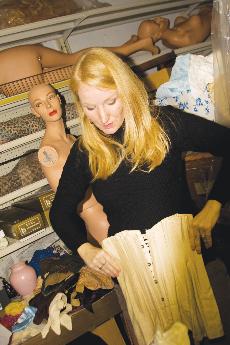Preserving the Past

Senior English major Tara Clark examines a corset.
For Tara Clark, senior English major, preserving historic garments isn’t about the clothes.
“Fashion is more than just clothing, it’s culture,” she said.
Wearing white gloves, reminiscent of the time period her dress is from, Clark meticulously lays out a jacket from the vintage clothing collection at the Dorothea B. Hoover Museum. On a foam and fabric dress form next to her cloth covered table is a blue gown Clark estimates to be from the late 1840s. She and her class mates will display a limited selection of the historic collection at the museum Nov. 18-23.
This dress and others like it are all being pulled from the basement of the museum to be cataloged and preserved by Ann Jaros, professor of theatre’s service learning class.
Jaros’ class started with a basement room of the complex stuffed full of vintage garments, and has managed to catalog a significant portion, however they do not expect to finish all the clothes.
“We’re making a dent,” Jaros said. “It’s expensive for the museum, but now these clothes are protected.”
Chris Wiseman, museum curator, says he hopes to work with other Southern students in the future.
“It’s a wonderful gift,” he said. “We can use students from any department, about the only thing we don’t cover here is biology.”
The students, mostly theatre majors, will catalog as much of the museums collection as possible, packing them away in garment boxes with acid free-tissue while gaining a knowledge of period clothing.
“It’s given me a real sense of empathy for those in the design and costume field,” said Jeremey Sailes, freshman theatre major. “As an actor, I knew somewhat the detail that was taken in creating a garment, but I’ve learned so much more of the full extent of what they would have to go through just for one article of clothing.
“It’s an amazing process.”
Like Clark, Sailes will be displaying a silk gown from the mid-1800s. Still in good condition, the dress has authentic buttons decorated with crescent moons, and the shoulders show signs of having been let out.
“The clothes, they create a timeline for me that connects me to more with the occupants of this town than I ever thought,” he said. “I could be restoring someone’s great great great grandmother’s wedding dress and if her great great great granddaughter saw it, I know that she would greatly appreciate it.”
While many of the outfits will be displayed on dress-forms created specifically for the garment, some, like sophomore theatre major Ashley Trotnic’s 1920s beaded dress are so delicate they must be displayed flat to protect the integrity of the cloth.
“I love it,” she said of her dress. “It’s so fragile because of the beading, it’ll fall apart in the hands.”
Many of the students involved in the restoration project are doing so for an understanding of costuming, but Clark is bringing her favorite literature to life.
Clark was encouraged by her adviser to take the service class.
“I don’t know how he knew, but I love it,” she said as she examines a child’s ivory silk nightgown with torn sleeves. “The people who lived here, they wore these.”
Interested by gender issues in literature, Clark says she can see the importance of a character’s clothing in certain pieces of writing. Holding an intricately stitched corset, yellowed with age up to her own waist, she says she can understand about what fashion says about society.
“Men were the ones who made women wear these,” she said. “A crinoline or hoop skirt, it’s like a cage.”
Your donation will support the student journalists of Missouri Southern State University. Your contribution will allow us to purchase equipment and cover our annual website hosting costs.



























